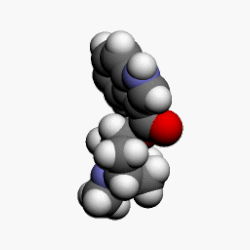Receptor (
ligands )
GlyR Tooltip Glycine receptor
Positive modulators:
Alcohols (e.g.,
brometone ,
chlorobutanol (chloretone) ,
ethanol (alcohol) ,
tert -butanol (2M2P)tribromoethanol ,
trichloroethanol ,
trifluoroethanol )
Alkylbenzene sulfonate
Anandamide
Barbiturates (e.g.,
pentobarbital ,
sodium thiopental )
Chlormethiazole
D12-116
Dihydropyridines (e.g.,
nicardipine )
Etomidate
Ginseng constituents (e.g.,
ginsenosides (e.g.,
ginsenoside-Rf ))
Glutamic acid (glutamate)
Ivermectin
Ketamine
Neuroactive steroids (e.g.,
alfaxolone ,
pregnenolone (eltanolone) ,
pregnenolone acetate ,
minaxolone ,
ORG-20599 )
Nitrous oxide
Penicillin G
Propofol
Tamoxifen
Tetrahydrocannabinol
Triclofos
Tropeines (e.g.,
atropine ,
bemesetron ,
cocaine ,
LY-278584 ,
tropisetron ,
zatosetron )
Volatiles /
gases (e.g.,
chloral hydrate ,
chloroform ,
desflurane ,
diethyl ether (ether) ,
enflurane ,
halothane ,
isoflurane ,
methoxyflurane ,
sevoflurane ,
toluene ,
trichloroethane (methyl chloroform) ,
trichloroethylene )
Xenon
Zinc Antagonists:
2-Aminostrychnine
2-Nitrostrychnine
4-Phenyl-4-formyl-N-methylpiperidine
αEMBTL
Bicuculline
Brucine
Cacotheline
Caffeine
Colchicine
Colubrine
Cyanotriphenylborate
Dendrobine
Diaboline
Endocannabinoids (e.g.,
2-AG ,
anandamide (AEA) )
Gaboxadol (THIP)
Gelsemine
iso-THAZ
Isobutyric acid
Isonipecotic acid
Isostrychnine
Laudanosine
N-Methylbicuculline
N-Methylstrychnine
N,N-Dimethylmuscimol
Nipecotic acid
Pitrazepin
Pseudostrychnine
Quinolines (e.g.,
4-hydroxyquinoline ,
4-hydroxyquinoline-3-carboxylic acid ,
5,7-CIQA ,
7-CIQ ,
7-TFQ ,
7-TFQA )
RU-5135
Sinomenine
Strychnine
Thiocolchicoside
Tutin Negative modulators:
Amiloride
Benzodiazepines (e.g.,
bromazepam ,
clonazepam ,
diazepam ,
flunitrazepam ,
flurazepam )
Corymine
Cyanotriphenylborate
Daidzein
Dihydropyridines (e.g.,
nicardipine ,
nifedipine ,
nitrendipine )
Furosemide
Genistein
Ginkgo constituents (e.g.,
bilobalide ,
ginkgolides (e.g.,
ginkgolide A ,
ginkgolide B ,
ginkgolide C ,
ginkgolide J ,
ginkgolide M ))
Imipramine
NBQX
Neuroactive steroids (e.g.,
3α-androsterone sulfate ,
3β-androsterone sulfate ,
deoxycorticosterone ,
DHEA sulfate ,
pregnenolone sulfate ,
progesterone )
Opioids (e.g.,
codeine ,
dextromethorphan ,
dextrorphan ,
levomethadone ,
levorphanol ,
morphine ,
oripavine ,
pethidine ,
thebaine )
Picrotoxin (i.e.,
picrotin and
picrotoxinin )
PMBA
Riluzole
Tropeines (e.g.,
bemesetron ,
LY-278584 ,
tropisetron ,
zatosetron )
Verapamil
Zinc
NMDAR Tooltip N-Methyl-D-aspartate receptor
Transporter (
blockers )
GlyT1 Tooltip Glycine transporter 1
GlyT2 Tooltip Glycine transporter 2
nAChRs Tooltip Nicotinic acetylcholine receptors
Agonists
PAMs Tooltip positive allosteric modulators )
5-HIAA
6-Chloronicotine
A-84,543
A-366,833
A-582,941
A-867,744
ABT-202
ABT-418
ABT-560
ABT-894
Acetylcholine
Altinicline
Anabasine
Anatabine
Anatoxin-a
AR-R17779
Bephenium hydroxynaphthoate
Butinoline
Butyrylcholine
Carbachol
Choline
Cotinine
Cytisine
Decamethonium
Desformylflustrabromine
Dianicline
Dimethylphenylpiperazinium
Epibatidine
Epiboxidine
Ethanol (alcohol)
Ethoxysebacylcholine
EVP-4473
EVP-6124
Galantamine
GTS-21
Ispronicline
Ivermectin
JNJ-39393406
Levamisole
Lobeline
MEM-63,908 (RG-3487)
Morantel
Nicotine (
tobacco )
NS-1738
PHA-543,613
PHA-709,829
PNU-120,596
PNU-282,987
Pozanicline
Pyrantel
Rivanicline
RJR-2429
Sazetidine A
SB-206553
Sebacylcholine
SIB-1508Y
SIB-1553A
SSR-180,711
Suberyldicholine
Suxamethonium (succinylcholine)
Suxethonium (succinyldicholine)
TC-1698
TC-1734
TC-1827
TC-2216
TC-5214
TC-5619
TC-6683
Tebanicline
Tribendimidine
Tropisetron
UB-165
Varenicline
WAY-317,538
XY-4083
Antagonists
NAMs Tooltip negative allosteric modulators )
Precursors (and
prodrugs )
5-HT1
5-HT1A
Agonists:
8-OH-DPAT
Adatanserin
Amphetamine
Antidepressants (e.g.,
etoperidone ,
hydroxynefazodone ,
nefazodone ,
trazodone ,
triazoledione ,
vilazodone ,
vortioxetine )
Atypical antipsychotics (e.g.,
aripiprazole ,
asenapine ,
brexpiprazole ,
cariprazine ,
clozapine ,
lurasidone ,
quetiapine ,
ziprasidone )
Azapirones (e.g.,
buspirone ,
eptapirone ,
gepirone ,
perospirone ,
tandospirone )
Bay R 1531
Befiradol
BMY-14802
Cannabidiol
Dimemebfe
Dopamine
Ebalzotan
Eltoprazine
Enciprazine
Ergolines (e.g.,
bromocriptine ,
cabergoline ,
dihydroergotamine ,
ergotamine ,
lisuride ,
LSD ,
methylergometrine (methylergonovine) ,
methysergide ,
pergolide )
F-11,461
F-12826
F-13714
F-14679
F-15063
F-15,599
Flesinoxan
Flibanserin
Flumexadol
Hypidone
Lesopitron
LY-293284
LY-301317
mCPP
MKC-242
Naluzotan
NBUMP
Osemozotan
Oxaflozane
Pardoprunox
Piclozotan
Rauwolscine
Repinotan
Roxindole
RU-24,969
S-14,506
S-14671
S-15535
Sarizotan
Serotonin (5-HT)
SSR-181507
Sunepitron
Tryptamines (e.g.,
5-CT ,
5-MeO-DMT ,
5-MT ,
bufotenin ,
DMT ,
indorenate ,
N-Me-5-HT ,
psilocin ,
psilocybin )
TGBA01AD
U-92,016-A
Urapidil
Vilazodone
Xaliproden
Yohimbine
Antagonists:
Atypical antipsychotics (e.g.,
iloperidone ,
risperidone ,
sertindole )
AV965
Beta blockers (e.g.,
alprenolol ,
carteolol ,
cyanopindolol ,
iodocyanopindolol ,
isamoltane ,
oxprenolol ,
penbutolol ,
pindobind ,
pindolol ,
propranolol ,
tertatolol )
BMY-7,378
CSP-2503
Dotarizine
Ergolines (e.g.,
metergoline )
FCE-24379
Flopropione
GR-46611
Isamoltane
Lecozotan
Mefway
Metitepine (methiothepin)
MIN-117 (WF-516)
MPPF
NAN-190
Robalzotan
S-15535
SB-649,915
SDZ 216-525
Spiperone
Spiramide
Spiroxatrine
UH-301
WAY-100135
WAY-100635
Xylamidine
5-HT1B
Agonists:
Anpirtoline
CGS-12066A
CP-93129
CP-94253
CP-122,288
CP-135807
Eltoprazine
Ergolines (e.g.,
bromocriptine ,
dihydroergotamine ,
ergotamine ,
methylergometrine (methylergonovine) ,
methysergide ,
pergolide )
mCPP
RU-24,969
Serotonin (5-HT)
Triptans (e.g.,
avitriptan ,
donitriptan ,
eletriptan ,
sumatriptan ,
zolmitriptan )
TFMPP
Tryptamines (e.g.,
5-BT ,
5-CT ,
5-MT ,
DMT )
Vortioxetine
5-HT1D
Agonists:
CP-122,288
CP-135807
CP-286601
Ergolines (e.g.,
bromocriptine ,
cabergoline ,
dihydroergotamine ,
ergotamine ,
LSD ,
methysergide )
GR-46611
L-694247
L-772405
mCPP
PNU-109291
PNU-142633
Serotonin (5-HT)
TGBA01AD
Triptans (e.g.,
almotriptan ,
avitriptan ,
donitriptan ,
eletriptan ,
frovatriptan ,
naratriptan ,
rizatriptan ,
sumatriptan ,
zolmitriptan )
Tryptamines (e.g.,
5-BT ,
5-CT ,
5-Et-DMT ,
5-MT ,
5-(nonyloxy)tryptamine ,
DMT )
5-HT1E
5-HT1F
5-HT2
5-HT2A
Agonists: 25H/NB series (e.g.,
25I-NBF ,
25I-NBMD ,
25I-NBOH ,
25I-NBOMe ,
25B-NBOMe ,
25C-NBOMe ,
25TFM-NBOMe ,
2CBCB-NBOMe ,
25CN-NBOH ,
2CBFly-NBOMe )
2Cs (e.g.,
2C-B ,
2C-E ,
2C-I ,
2C-T-2 ,
2C-T-7 ,
2C-T-21 )
2C-B-FLY
2CB-Ind
5-Methoxytryptamines (
5-MeO-DET ,
5-MeO-DiPT ,
5-MeO-DMT ,
5-MeO-DPT ,
5-MT )
α-Alkyltryptamines (e.g.,
5-Cl-αMT ,
5-Fl-αMT ,
5-MeO-αET ,
5-MeO-αMT ,
α-Me-5-HT ,
αET ,
αMT )
AL-34662
AL-37350A
Bromo-DragonFLY
Dimemebfe
DMBMPP
DOx (e.g.,
DOB ,
DOC ,
DOI ,
DOM )
Efavirenz
Ergolines (e.g.,
1P-LSD ,
ALD-52 ,
bromocriptine ,
cabergoline ,
ergine (LSA) ,
ergometrine (ergonovine) ,
ergotamine ,
lisuride ,
LA-SS-Az ,
LSB ,
LSD ,
LSD-Pip ,
LSH ,
LSP ,
methylergometrine (methylergonovine) ,
pergolide )
Flumexadol
IHCH-7113
Jimscaline
Lorcaserin
MDxx (e.g.,
MDA (tenamfetamine) ,
MDMA (midomafetamine) ,
MDOH ,
MMDA )
O-4310
Oxaflozane
PHA-57378
PNU-22394
PNU-181731
RH-34
SCHEMBL5334361
Phenethylamines (e.g.,
lophophine ,
mescaline )
Piperazines (e.g.,
BZP ,
quipazine ,
TFMPP )
Serotonin (5-HT)
TCB-2
TFMFly
Tryptamines (e.g.,
5-BT ,
5-CT ,
bufotenin ,
DET ,
DiPT ,
DMT ,
DPT ,
psilocin ,
psilocybin ,
tryptamine )
Antagonists:
5-I-R91150
5-MeO-NBpBrT
AC-90179
Adatanserin
Altanserin
Antihistamines (e.g.,
cyproheptadine ,
hydroxyzine ,
ketotifen ,
perlapine )
AMDA
Atypical antipsychotics (e.g.,
amperozide ,
aripiprazole ,
asenapine ,
blonanserin ,
brexpiprazole ,
carpipramine ,
clocapramine ,
clorotepine ,
clozapine ,
fluperlapine ,
gevotroline ,
iloperidone ,
lurasidone ,
melperone ,
mosapramine ,
ocaperidone ,
olanzapine ,
paliperidone ,
quetiapine ,
risperidone ,
sertindole ,
zicronapine ,
ziprasidone ,
zotepine )
Chlorprothixene
Cinanserin
CSP-2503
Deramciclane
Dotarizine
Eplivanserin
Ergolines (e.g.,
amesergide ,
LY-53857 ,
LY-215,840 ,
mesulergine ,
metergoline ,
methysergide ,
sergolexole )
Fananserin
Flibanserin
Glemanserin
Irindalone
Ketanserin
KML-010
Landipirdine
LY-393558
mCPP
Medifoxamine
Metitepine (methiothepin)
MIN-117 (WF-516)
Naftidrofuryl
Nantenine
Nelotanserin
Opiranserin (VVZ-149)
Pelanserin
Phenoxybenzamine
Pimavanserin
Pirenperone
Pizotifen
Pruvanserin
Rauwolscine
Ritanserin
Roluperidone
S-14671
Sarpogrelate
Serotonin antagonists and reuptake inhibitors (e.g.,
etoperidone ,
hydroxynefazodone ,
lubazodone ,
mepiprazole ,
nefazodone ,
triazoledione ,
trazodone )
SR-46349B
TGBA01AD
Teniloxazine
Temanogrel
Tetracyclic antidepressants (e.g.,
amoxapine ,
aptazapine ,
esmirtazapine ,
maprotiline ,
mianserin ,
mirtazapine )
Tricyclic antidepressants (e.g.,
amitriptyline )
Typical antipsychotics (e.g.,
chlorpromazine ,
fluphenazine ,
haloperidol ,
loxapine ,
perphenazine ,
pimozide ,
pipamperone ,
prochlorperazine ,
setoperone ,
spiperone ,
spiramide ,
thioridazine ,
thiothixene ,
trifluoperazine )
Volinanserin
Xylamidine
Yohimbine
5-HT2B
Agonists:
4-Methylaminorex
Aminorex
Amphetamines (e.g.,
chlorphentermine ,
cloforex ,
dexfenfluramine ,
fenfluramine ,
levofenfluramine ,
norfenfluramine )
BW-723C86
DOx (e.g.,
DOB ,
DOC ,
DOI ,
DOM )
Ergolines (e.g.,
cabergoline ,
dihydroergocryptine ,
dihydroergotamine ,
ergotamine ,
methylergometrine (methylergonovine) ,
methysergide ,
pergolide )
Lorcaserin
MDxx (e.g.,
MDA (tenamfetamine) ,
MDMA (midomafetamine) ,
MDOH ,
MMDA )
Piperazines (e.g.,
TFMPP )
PNU-22394
Ro60-0175
Serotonin (5-HT)
Tryptamines (e.g.,
5-BT ,
5-CT ,
5-MT ,
α-Me-5-HT ,
bufotenin ,
DET ,
DiPT ,
DMT ,
DPT ,
psilocin ,
psilocybin ,
tryptamine )
Antagonists:
Agomelatine
Atypical antipsychotics (e.g.,
amisulpride ,
aripiprazole ,
asenapine ,
brexpiprazole ,
cariprazine ,
clozapine ,
N-desalkylquetiapine (norquetiapine) ,
N-desmethylclozapine (norclozapine) ,
olanzapine ,
pipamperone ,
quetiapine ,
risperidone ,
ziprasidone )
Cyproheptadine
EGIS-7625
Ergolines (e.g.,
amesergide ,
bromocriptine ,
lisuride ,
LY-53857 ,
LY-272015 ,
mesulergine )
Ketanserin
LY-393558
mCPP
Metadoxine
Metitepine (methiothepin)
Pirenperone
Pizotifen
Propranolol
PRX-08066
Rauwolscine
Ritanserin
RS-127445
Sarpogrelate
SB-200646
SB-204741
SB-206553
SB-215505
SB-221284
SB-228357
SDZ SER-082
Tegaserod
Tetracyclic antidepressants (e.g.,
amoxapine ,
mianserin ,
mirtazapine )
Trazodone
Typical antipsychotics (e.g.,
chlorpromazine )
TIK-301
Yohimbine
5-HT2C
Agonists:
2Cs (e.g.,
2C-B ,
2C-E ,
2C-I ,
2C-T-2 ,
2C-T-7 ,
2C-T-21 )
5-Methoxytryptamines (
5-MeO-DET ,
5-MeO-DiPT ,
5-MeO-DMT ,
5-MeO-DPT ,
5-MT )
α-Alkyltryptamines (e.g.,
5-Cl-αMT ,
5-Fl-αMT ,
5-MeO-αET ,
5-MeO-αMT ,
α-Me-5-HT ,
αET ,
αMT )
A-372159
AL-38022A
Alstonine
CP-809101
Dimemebfe
DOx (e.g.,
DOB ,
DOC ,
DOI ,
DOM )
Ergolines (e.g.,
ALD-52 ,
cabergoline ,
dihydroergotamine ,
ergine (LSA) ,
ergotamine ,
lisuride ,
LA-SS-Az ,
LSB ,
LSD ,
LSD-Pip ,
LSH ,
LSP ,
pergolide )
Flumexadol
Lorcaserin
MDxx (e.g.,
MDA (tenamfetamine) ,
MDMA (midomafetamine) ,
MDOH ,
MMDA )
MK-212
ORG-12962
ORG-37684
Oxaflozane
PHA-57378
Phenethylamines (e.g.,
lophophine ,
mescaline )
Piperazines (e.g.,
aripiprazole ,
BZP ,
mCPP ,
quipazine ,
TFMPP )
PNU-22394
PNU-181731
Ro60-0175
Ro60-0213
Serotonin (5-HT)
Tryptamines (e.g.,
5-BT ,
5-CT ,
bufotenin ,
DET ,
DiPT ,
DMT ,
DPT ,
psilocin ,
psilocybin ,
tryptamine )
Vabicaserin
WAY-629
WAY-161503
YM-348
Antagonists:
Adatanserin
Agomelatine
Atypical antipsychotics (e.g.,
asenapine ,
clorotepine ,
clozapine ,
fluperlapine ,
iloperidone ,
melperone ,
olanzapine ,
paliperidone ,
quetiapine ,
risperidone ,
sertindole ,
ziprasidone ,
zotepine )
Captodiame
CEPC
Cinanserin
Cyproheptadine
Deramciclane
Desmetramadol
Dotarizine
Eltoprazine
Ergolines (e.g.,
amesergide ,
bromocriptine ,
LY-53857 ,
LY-215,840 ,
mesulergine ,
metergoline ,
methysergide ,
sergolexole )
Etoperidone
Fluoxetine
FR-260010
Irindalone
Ketanserin
Ketotifen
Latrepirdine (dimebolin)
Medifoxamine
Metitepine (methiothepin)
Nefazodone
Pirenperone
Pizotifen
Propranolol
Ritanserin
RS-102221
S-14671
SB-200646
SB-206553
SB-221284
SB-228357
SB-242084
SB-243213
SDZ SER-082
Tedatioxetine
Tetracyclic antidepressants (e.g.,
amoxapine ,
aptazapine ,
esmirtazapine ,
maprotiline ,
mianserin ,
mirtazapine )
TIK-301
Tramadol
Trazodone
Tricyclic antidepressants (e.g.,
amitriptyline ,
nortriptyline )
Typical antipsychotics (e.g.,
chlorpromazine ,
loxapine ,
pimozide ,
pipamperone ,
thioridazine )
Xylamidine
5-HT3 –
7
5-HT3
Agonists:
Alcohols (e.g.,
butanol ,
ethanol (alcohol) ,
trichloroethanol )
m-CPBG
Phenylbiguanide
Piperazines (e.g.,
BZP ,
mCPP ,
quipazine )
RS-56812
Serotonin (5-HT)
SR-57227
SR-57227A
Tryptamines (e.g.,
2-Me-5-HT ,
5-CT ,
bufotenidine (5-HTQ) )
Volatiles/gases (e.g.,
halothane ,
isoflurane ,
toluene ,
trichloroethane )
YM-31636
Antagonists:
Alosetron
Anpirtoline
Arazasetron
AS-8112
Atypical antipsychotics (e.g.,
clozapine ,
olanzapine ,
quetiapine )
Azasetron
Batanopride
Bemesetron (MDL-72222)
Bupropion
Cilansetron
CSP-2503
Dazopride
Dolasetron
Galanolactone
Granisetron
Hydroxybupropion
Lerisetron
Memantine
Ondansetron
Palonosetron
Ramosetron
Renzapride
Ricasetron
Tedatioxetine
Tetracyclic antidepressants (e.g.,
amoxapine ,
mianserin ,
mirtazapine )
Thujone
Tropanserin
Tropisetron
Typical antipsychotics (e.g.,
loxapine )
Volatiles/gases (e.g.,
nitrous oxide ,
sevoflurane ,
xenon )
Vortioxetine
Zacopride
Zatosetron
5-HT4
5-HT5A
5-HT6
Agonists:
Ergolines (e.g.,
dihydroergocryptine ,
dihydroergotamine ,
ergotamine ,
lisuride ,
LSD ,
mesulergine ,
metergoline ,
methysergide )
Hypidone
Serotonin (5-HT)
Tryptamines (e.g.,
2-Me-5-HT ,
5-BT ,
5-CT ,
5-MT ,
Bufotenin ,
E-6801 ,
E-6837 ,
EMD-386088 ,
EMDT ,
LY-586713 ,
N-Me-5-HT ,
ST-1936 ,
tryptamine )
WAY-181187
WAY-208466
Antagonists:
ABT-354
Atypical antipsychotics (e.g.,
aripiprazole ,
asenapine ,
clorotepine ,
clozapine ,
fluperlapine ,
iloperidone ,
olanzapine ,
tiospirone )
AVN-101
AVN-211
AVN-322
AVN-397
BGC20-760
BVT-5182
BVT-74316
Cerlapirdine
EGIS-12,233
GW-742457
Idalopirdine
Ketanserin
Landipirdine
Latrepirdine (dimebolin)
Masupirdine
Metitepine (methiothepin)
MS-245
PRX-07034
Ritanserin
Ro 04-6790
Ro 63-0563
SB-258585
SB-271046
SB-357134
SB-399885
SB-742457
Tetracyclic antidepressants (e.g.,
amoxapine ,
mianserin )
Tricyclic antidepressants (e.g.,
amitriptyline ,
clomipramine ,
doxepin ,
nortriptyline )
Typical antipsychotics (e.g.,
chlorpromazine ,
loxapine )
5-HT7
Antagonists:
Atypical antipsychotics (e.g.,
amisulpride ,
aripiprazole ,
asenapine ,
brexpiprazole ,
clorotepine ,
clozapine ,
fluperlapine ,
olanzapine ,
risperidone ,
sertindole ,
tiospirone ,
ziprasidone ,
zotepine )
Butaclamol
DR-4485
EGIS-12,233
Ergolines (e.g.,
2-Br-LSD (BOL-148) ,
amesergide ,
bromocriptine ,
cabergoline ,
dihydroergotamine ,
ergotamine ,
LY-53857 ,
LY-215,840 ,
mesulergine ,
metergoline ,
methysergide ,
sergolexole )
JNJ-18038683
Ketanserin
LY-215,840
Metitepine (methiothepin)
Ritanserin
SB-258719
SB-258741
SB-269970
SB-656104
SB-656104A
SB-691673
SLV-313
SLV-314
Spiperone
SSR-181507
Tetracyclic antidepressants (e.g.,
amoxapine ,
maprotiline ,
mianserin ,
mirtazapine )
Tricyclic antidepressants (e.g.,
amitriptyline ,
clomipramine ,
imipramine )
Typical antipsychotics (e.g.,
acetophenazine ,
chlorpromazine ,
chlorprothixene ,
fluphenazine ,
loxapine ,
pimozide )
Vortioxetine

